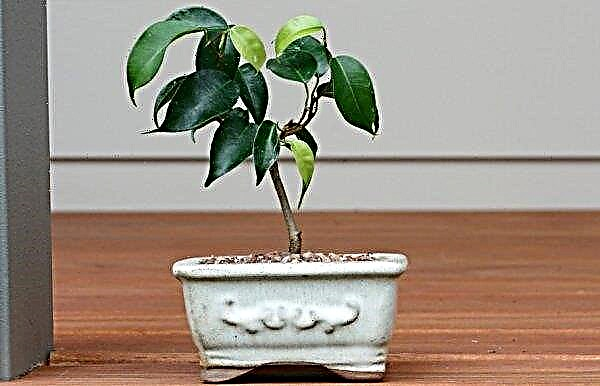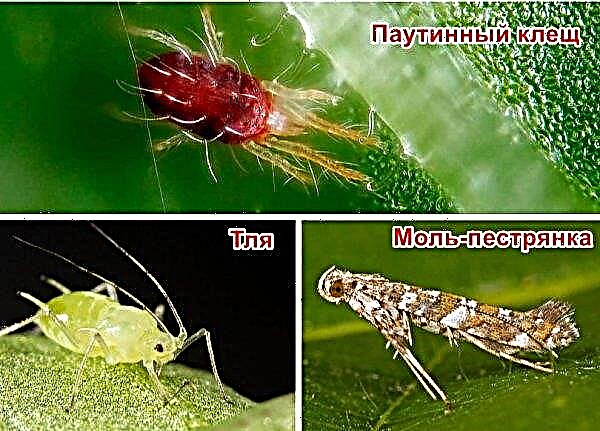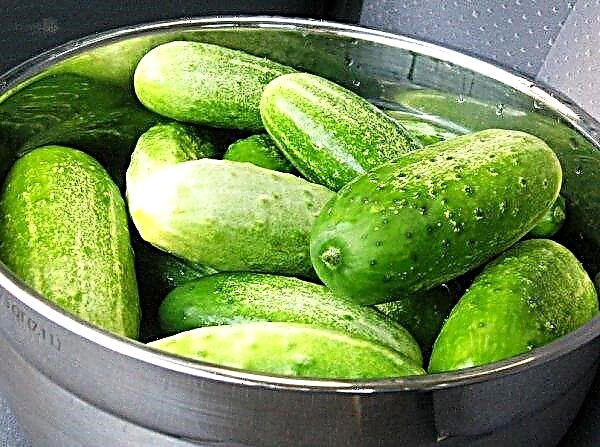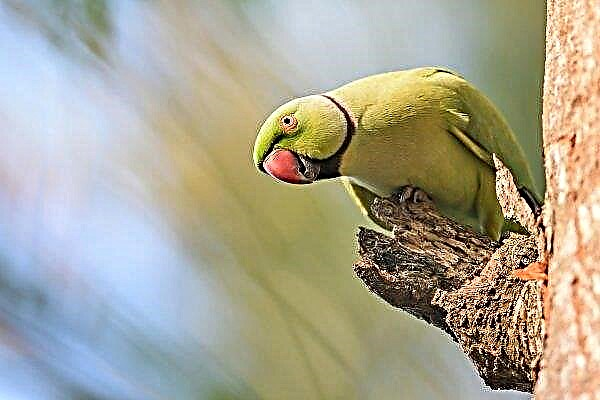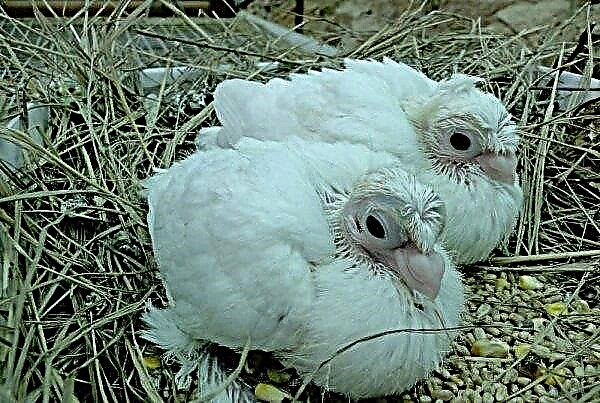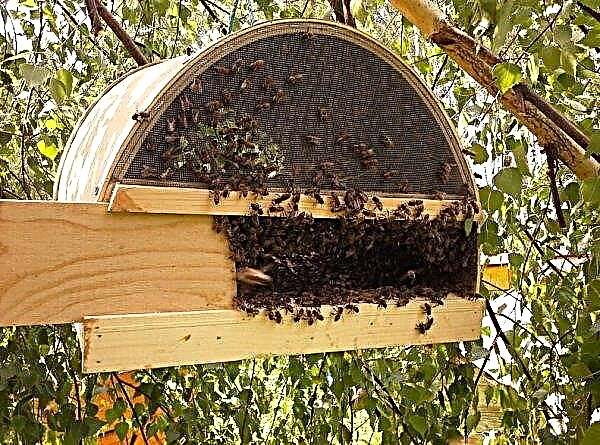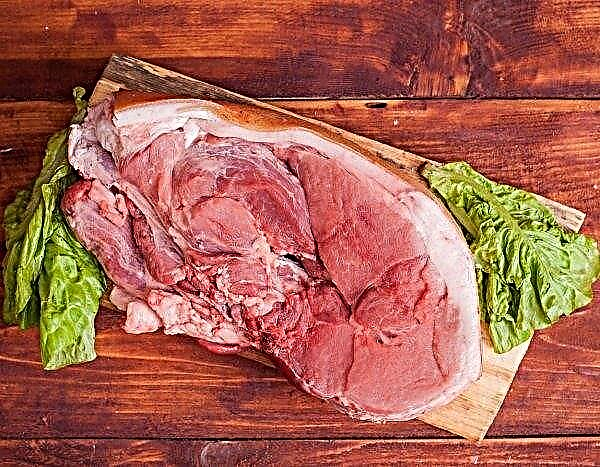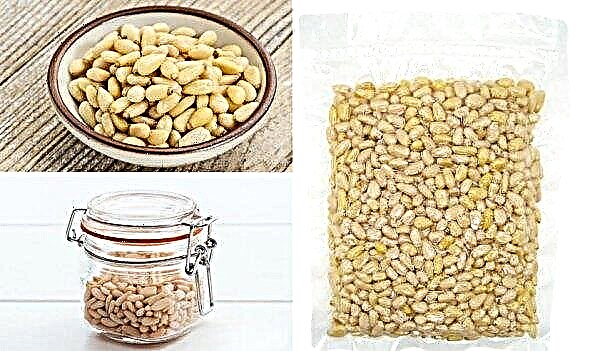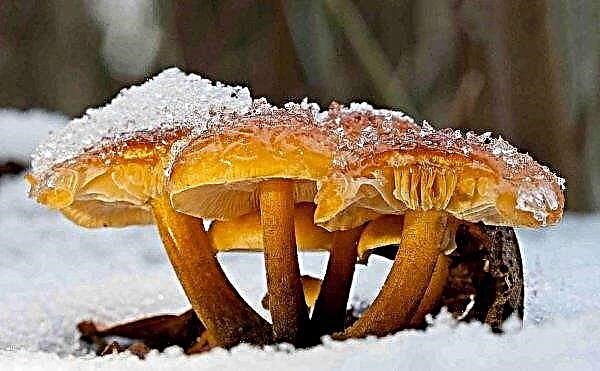Long-term scientific research allowed to obtain eggplant varieties and hybrids that are resistant to a sharp change in temperature, undemanding to the composition of the soil. With the correct implementation of each stage of growing this vegetable crop, you can get a good harvest. The article provides complete information about the eggplant variety Black handsome, who has proven himself excellently among agricultural enthusiasts.
Eggplant story Black handsome
Work on the development of a new variety has been carried out since the middle of the last century, and in 2003 the breeders of Agrofirm Search LLC (Russia) completed the tests. In 2006, the variety Black Beauty was placed in the State Registration of Breeding Achievements.
Did you know? In Europe, eggplant began to be consumed as a vegetable crop in the 18th century. Previously, the plant was used only for decorative and medicinal purposes.
Description and characteristics of the variety
Eggplant Black handsome is not a hybrid (found in many sources), it is a non-industrial variety of medium-term maturity, intended for growing in open ground in private farms, but can be cultivated in a greenhouse. Initially recommended for cultivation in the North Caucasus and Central Black Earth regions. Seedlings are planted in open ground (in regions with a stable warm climate, sowing by seeds is allowed): bushes grow intensively, while remaining compact (semi-spreading, plant height about 70 cm).
Seedlings are planted in open ground (in regions with a stable warm climate, sowing by seeds is allowed): bushes grow intensively, while remaining compact (semi-spreading, plant height about 70 cm).
The stems are painted in lilac or bluish color - it depends on the acidity of the soil, the leaves are green, medium-sized with serrated edges. The variety is mid-season, closer to the late - depending on climatic conditions. Productivity is from 5 to 9 kg per square meter.
The fruits of eggplant are dark purple, almost black in color, pear-shaped, elongated, about 20 cm long. The weight of the vegetable is approximately 150-200 g. The color of the pulp is creamy, the seeds are small. In not overripe fruits bitterness is completely absent.
Young fruits have a delicate dense texture of pulp, a thin peel. It is recommended to use them without additional soaking in salt water and with minimal heat treatment.
Rules for growing seedlings and caring for them
Eggplant is a whimsical vegetable crop. A strict sequence of actions and compliance with the recommendations at each stage of cultivation of this kind of solanaceous guarantee a good harvest.
Preparing seeds for seedlings
Seeds must be sorted and preventive disinfection is carried out. It is important to eliminate the risk of infection of plants with fungal and viral infections, the causative agents of which can be found on the surface of the seeds.
Important! Seeds purchased in specialized stores and packaged in compliance with selective control do not need additional disinfection.
For this, the material is placed in a saturated solution of potassium permanganate and incubated in it for half an hour, after which it is washed with water. It is further recommended to stimulate germination. For this, the seed is placed in a solution of a natural stimulant, for example, sodium humate (according to the instructions for use), or in a solution of wood ash (2 tbsp. Per 1 liter of hot water, infused for a day). For these purposes, aqueous aloe extract is also used (proportion 1:10).
It is further recommended to stimulate germination. For this, the seed is placed in a solution of a natural stimulant, for example, sodium humate (according to the instructions for use), or in a solution of wood ash (2 tbsp. Per 1 liter of hot water, infused for a day). For these purposes, aqueous aloe extract is also used (proportion 1:10).
Capacity selection
Eggplant seedlings have a weak root system that is easily damaged during transplantation, therefore, seeds are recommended to be planted immediately in separate vessels, excluding subsequent picking.
It can be:
- special pots for seedlings;
- peat pots;
- large disposable glasses with drainage holes made at the bottom.
Soil preparation
The soil intended for growing eggplant seedlings should not be acidic, loose, enriched with nutrients and trace elements. You can purchase special primers for solanaceous vegetables in the store. Their undoubted advantage is a balanced composition, a guarantee of the absence of pathogens, the presence of fertilizers.
Also, the soil for planting is prepared independently, adhering to the following proportions:
- 2 parts of dung or compost humus;
- 1 part peat;
- 0.5 parts of rotted sawdust;
- 0.5 parts of coarse sand (if clay soil).
You can use the soil from the garden, where cabbage or cucumbers grew before that.
Sowing seeds
- It is not recommended to sow dry seeds, since germination can take up to 25 days, and the risk of germination is very high. Seeds are placed in a damp cloth, wrapped with plastic wrap to avoid drying out and left for 5 days in a warm place until a small sprout appears.
- After the emergence of the sprouts in one prepared container with soil (2 hours before planting, the soil is shed with a weak warm solution of potassium permanganate), 2-3 seeds are placed at a sufficient distance from each other to a depth of 2 cm.
- After planting, the seeds are sprinkled with a thin loose layer of earth, slightly compacted. No watering required.
- Glasses are covered with plastic wrap so that the temperature inside the greenhouse does not drop below + 25 ° C.
- In the process of formation and growth of seedlings, weaker plants are cut, leave one.
Important! It is strictly forbidden to place seeds on an open heating battery - from overheating, they will dry out and will not germinate.
Watering
- Eggplant seedlings are very demanding regarding watering. It should be remembered that the woodiness of the stems of seedlings is a direct consequence of the lack of moisture in the soil, the potential yield will be reduced. Excess moisture contributes to the occurrence of fungal diseases, rot.
- Watering plants should be in the morning (in the evening, growth is activated), approximately once every 5 days. Water for irrigation is used at room temperature, filtered, without chlorine impurities. In the first three, for the appearance of sprouts, watering is not recommended.
- If the seedlings are in a room with low humidity and high temperature, plants are watered more often (every 3-4 days), after which they very carefully loosen the soil, fearing damage to the roots.
- Due to the slow formation of the root system, water is applied directly under the root.

Temperature mode
Eggplant is a heat-loving vegetable crop, especially sensitive to temperature changes at the growth stage. Accordingly, it is important to ensure that during the daytime in the room the temperature is not lower than + 18 ° C, at night - + 16 ° C.
At the indicated temperature indicators, the necessary hardening of plants occurs before planting in open ground. The optimal temperature range is considered to be from + 23 ° С to + 25 ° С.
Top dressing
The first feeding is carried out with mineral fertilizers two weeks after transplanting the seedlings into a more spacious pot (after the appearance of the first two true leaves), such as:
- "Kemira station wagon", "Solution", nitrofoska - 1 hour per 5 liters of water;
- “Ideal” - 1 cap per 1 liter of water;
- “Effect” - 1 hour per 1 liter of water.
The last two fertilizers include growth humic substances.
The second top dressing is carried out without fail with the use of phosphorus and potassium.
It is recommended to prepare at home a mixture of the following components:
- ammonium nitrate - 0.5 g;
- superphosphate - 1.5 g;
- potassium sulfate - 1 g;
- water - 1 liter.
If necessary, make a small amount of organic fertilizers, such as Biohumus, Biosad, a weak solution of bird droppings. Feeding, like watering, is carried out directly under the root of the plant. Avoid contact with leaves due to the risk of burns.
Feeding, like watering, is carried out directly under the root of the plant. Avoid contact with leaves due to the risk of burns.
Lighting
A daylight deficiency adversely affects growing plants. They stretch, the stem becomes thinner, the leaves become smaller or completely stop growing, the buds are formed late. To avoid the above negative consequences, the pots are placed on the windowsill for maximum illumination.
In addition to natural light, it is necessary to take care of additional sources of lighting, since for the full development of eggplant seedlings it takes 14 hours of light day. It can be fluorescent lamps, phytolamps (diode lamps), sodium lamps.
Rules for planting seedlings
Transplantation is a painful procedure for plants, especially from home to open ground.
Important! If the weather is sunny, it is better to transplant the seedlings in the evening, with cloudy ones in the morning.
In order to minimize the possible negative consequences of a transplant, certain rules should be followed:
- A few days before the planned date of transplantation, the seedlings cease to be watered, and an hour before planting in open ground, they are spilled abundantly with water so that the earthen lump does not crumble when removed from the planting capacity. Plants in peat pots are lowered into the prepared hole in the ridge without being removed from the tank.
- The plant should be removed from the plastic container gently, holding the plant stem between the index and middle fingers, with the second hand you need to turn the container over, while pulling the container towards you. After extracting the seedlings, holding a lump of earth, quickly place the plant in a very moist hole in the garden.
- The term for planting in the open ground for the Black Prince eggplant is from the beginning to mid-June.

Care Features
The basic rules for caring for eggplant varieties of Black Beauty practically do not differ from the general rules of agricultural technology of the mentioned vegetable culture.
However, some features of the variety must be taken into account:
- When the seedlings are placed in open ground, it is recommended to cover it with film for one or two weeks, since a sharp drop in temperature is detrimental to fragile seedlings. The culture is extremely demanding on light, so the covering material is not used in the daytime.
- After transplanting, it is advisable not to water the plants for a couple of weeks, but to carefully spray them, occasionally adding urea to the water.
- After the seedlings get stronger, watering is carried out regularly, under the root, with water at a temperature of + 25 ° C, avoiding overmoistening of the soil. Cold water slows down plant growth. After the fruit is formed, you can water the bushes from above (with a manual watering can).
- The handsome black man is a tall plant, so you need to pinch the top of the bush when the stem height reaches about 20 cm (maximum - 35 cm). Without fail, leaves and lateral processes are removed before the first branch. This is necessary for the formation of a powerful plant and full fruits.
Fertilizing vegetables is carried out three times a season with mineral and organic (a solution of manure or bird droppings) fertilizers:
- the first - 10 days after transplanting seedlings in open ground;
- the second - even 10 days after the first feeding;
- the third - at the beginning of active fruiting.
Weeding and hilling on a regular basis are necessary for the formation of developed subordinate roots.
Disease and Pest Treatment
Processing with chemical compounds is carried out exclusively before the flowering of plants. The fight against plant diseases and pests involves the processing of leaves, stems, and soil of growth.
The drugs are divided into three main groups:
- Chemicals. They give a quick result, but are toxic. They have the ability to accumulate in the fruits, negatively affect people's health.
- Biochemical preparations - Do not adversely affect human health, are harmless to plants, animals, insects. However, they require constant regular use - a single use is ineffective.
- Folk remedies - decoctions, infusions of herbs and plants with a detrimental effect for diseases and pests.
Eggplant A black handsome man is less susceptible to diseases compared to other varieties, the main thing is to adhere to the proper cultivation of plants, so that there are no prerequisites for diseases. It is important not to allow the green mass to thicken, to observe the regime of watering and lighting, to regularly weed, loosen and spud plants.
Most often, the variety is susceptible to black leg disease, in the fight against which bleach helps.
But the pests - the Colorado potato beetle, slugs, and bear, are a serious threat to the handsome Black. The Colorado potato beetle is picked by hand, twice a day - in the morning and in the evening, bushes sprinkled with wood ash. Spices with a pungent odor relieve slugs: you should treat the plants with fine powder of mustard or black pepper.
Traps help fight a bear - bottle with a narrow neck is buried in the ground and a small amount of beer is poured into them. The smell of a hop drink attracts the bear, it falls into the trap and cannot get out of it. Pest plants with spicy pungent odors - wormwood, garlic shooters, calendula, tagetis (marigolds) repel pests well.
Harvesting and Harvesting
- Collect eggplant fruit is recommended when reaching a size that matches the variety. For the Black Handsome, this is 20 cm. The vegetable should be elastic when pressed, with a smooth glossy peel of almost black color.
- Harvesting is done in dry weather, in the morning. Wash fruits before storage is not recommended.
- Eggplant Black handsome, grown without disturbing the techniques of agricultural technology, have a thin peel, delicate fine-grained pulp, bitterness is absent. In cooking, they are used without additional processing (soaking, freezing), which increases the taste and nutritional value.
Important! Heat treatment does not destroy the nutrients of eggplant, unlike most vegetables, which is why it is so valuable in dietary nutrition.
Eggplant Black handsome - demanding care and needs constant attention from the gardener, however, all efforts will be rewarded when dark purple glossy fruits appear on the bushes.

